The USA’s M3/M5 Stuart family is a fairly well-known tank used by numerous countries during and after WWII. In the case of Brazil, what makes the story interesting is the variety of modifications done to Stuarts decades after WWII had ended.

(Brazilian M3 Stuarts on the Italian front during WWII. These are early-production tanks, still with the nearly-useless sponson machine guns and prewar hatch design.)
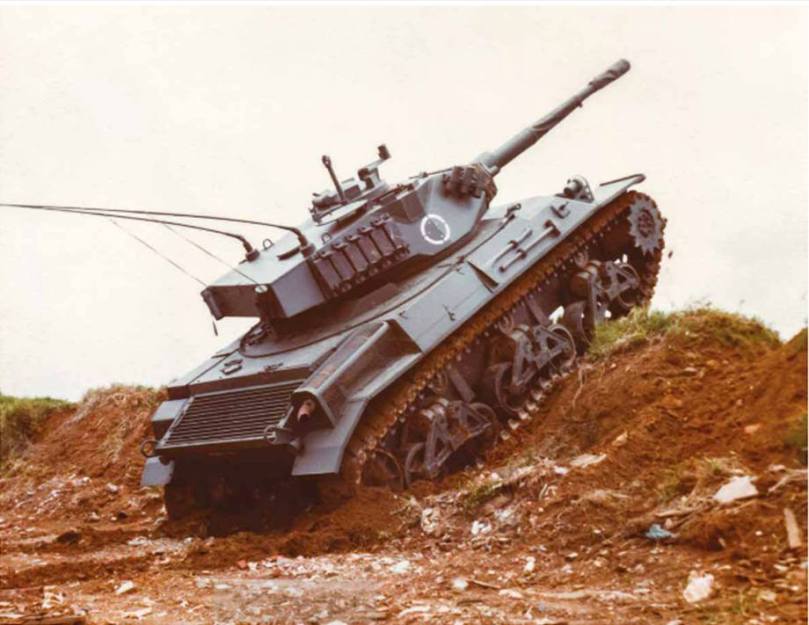
(Brazilian X1A2 Carcara tank of the 1980s; the last member of the M3 family tree.)

(The XLF-40 ballistic missile system of the 1970s.)
the Stuart tank: general characteristics
The M3 Stuart was in production and service when the USA entered WWII in 1941, and remained in production until superseded by the M24 Chaffee in 1944. “Stuart” was technically never an official designation; during WWII the British army assigned Lend-Leased AFVs codenames from great generals of the USA’s civil war. In this case, Confederate MajGen. J.E.B. Stuart. American soldiers quickly began referring to the M3 and later the M5 by that name as well.
This tank weighed 15¼ tons and was 15’11” long, 7’6″ wide, and 8′ tall. It was armed with a M6 37mm hand-loaded gun with 147 rounds onboard. The secondary armament varied, there was always a M1919A4 (.30-06 Springfield) coaxial and the same in the bow; sometimes a roof AA gun of different types was added as well. Early models had sponson guns which were nearly useless and later removed.
The Stuart had a 4-man crew: commander, gunner, driver, and “fourth man” who operated the bow machine gun and also could relieve the driver if needed.

(Brazil received 20 of the basic M3 version in 1942, and 330 of the M3A1 / M3A3 versions throughout the rest of WWII. This placard was on a M3 sold to a collector in the late 1980s.)
The armor of the Stuart was, by pre-WWII standards when it was designed, decent for a tank in the “light” category: the hull had 1″ on the sides and 1¼” – 1¾” in front, and the turret 1½” with a 2″ mantlet.

(Turret of a Brazilian M3A1, the most common type in Brazilian use. Earlier basic M3s had simple flap-type side hatches, while later M3A3s had an overhang on the turret rear that housed a bulky radio during WWII.)
During WWII Brazil received 350 Stuart tanks. The versions delivered to Brazil used either a Guiberson A-1020 radial 9-cylinder diesel or a Continental R-670 radial 7-cylinder gasoline engine. There was a 70hp difference between the two but by adjusting use of the Syncromesh transmission, the same performance could be delivered: 36mph on paved roads and about half that cross-country. The engines were started with a powder cartridge that looked like a large shotgun shell.

(Guiberson A-1020 diesel taken from a Brazilian Stuart.)
All of the Stuarts used by Brazil had vertical-volute suspension and T16E1 66-link tracks.
after WWII
Stuarts of all models continued in Brazilian use after Germany’s May 1945 surrender (the country did not redeploy any forces into the Pacific theatre before WWII ended altogether in September 1945). The tanks, especially the M3A1 and M3A3s, continued in use with active duty tank units into the 1970s.

(Stuart on a training course in Brazil during the mid-1940s. After WWII – in some cases, during the war – the two sponson machine guns were deleted if they had been installed to begin with, and the openings covered with a circular armor patch as shown.)

(Stuarts on parade in Sao Paulo in the mid-1950s. After WWII, the Brazilian army tried to organize these tanks into platoons by engine type – this being an all-Guiberson unit.)

(Brazilian M3A1 during a 1955 parade.)

(M3A1 Stuart during a night exercise in the late 1960s. The machine guns are M1919s, also WWII-era gear.)

(M3A1 on parade during the 1970s, this one having a post-WWII radio and M1919 commander’s gun fitted.)

(A pair of Stuarts in 1983, the final year in which the baseline WWII-configuration tanks were in active duty use in Brazil. Brazil ceased spare parts support for the warehoused baseline tanks in 1988.)
By the 1970s the Stuart was obsolete. The hand-loaded 37mm gun was too puny for anti-tank use and too slow-firing for infantry support roles. None the less, the WWII tanks were still in good condition and offered decent mobility.
At the same time, Brazil’s options for new light tanks were narrowing. Relations with the USA soured during President Ford’s administration due to Brazil signing an atomic energy agreement with West Germany, and deteriorated even further after President Carter was elected. Second-hand tanks from Europe would require dipping into foreign currency reserves and in many cases, get tied up in technology re-export restrictions from the United States.
At this time, Brazil still had about 160 of the original 350 Stuarts delivered during WWII operational, with maybe another ninety or so in storage.
It was therefore decided to modernize some of the remaining WWII Stuarts in Brazil, as “Projeto CCL-MB-1”. The tank series was later redesignated “X1”.

(The prototype Stuart conversion.)
the X1 / X1A Pioneiro
The company chosen was Bernardini S/A in Sao Paulo, Brazil. Originally a manufacturer of bank safes, this company had successfully overhauled some of Brazil’s WWII-vintage M8 Greyhound armored cars. This project would be its most challenging task to date, as the “upgrade” would in fact be nearly a complete rebuild of the WWII tank.

(The three engine testbeds during the competition.)
The WWII powerplant was an obvious item to be changed, be it the Guiberson radial diesel or Continental gasoline engine. Three Stuarts were re-engined with modern diesels: one with a Deutz, one with a MWM, and one with a Saab-Scania. The Deutz design, an air-cooled V-8 diesel, won the competition however that company withdrew from the X1 project as it was just beginning. The runner-up, the Saab design, was thus selected.

(photo via preservedtanks.com website)
The hull armor was altered, with the WWII steel being stripped off in all but the lower glacis portions above the tracks and ahead of the engine firewall. This itself was not easy, as the later WWII Stuart variants used a combination of riveted armor and hard-welded armor. It replaced by sloped high-strength alloy steel made by Biselli. The front of the tank was now guaranteed to defeat Mk.IIZ 20mm AP (British), 20x145mm(R) (Swedish), Mk9 and M75 20mm AP-T (American), 14.5x114mm AP (Soviet), and 20x139mm FMK (Swiss) at most relevant ranges, and could defeat 23x152mm(B) AP (Soviet) at some ranges and impact angles. This was pretty much everything medium-caliber in South America which the Brazilians expected to be thrown against it. Against heavier weaponry, obviously no little tank of the Stuart’s size could survive anyways.
Paradoxically the X1 was not expected to survive engagements with other tanks, but was expected to be able to destroy them.
To that end the WWII turret was entirely discarded. The new Brazilian turret was made of electrowelded steel and offered protection equal to the new hull armor. A modern optics package designed in Brazil was installed. The new main gun was a French-made DEFA D-921A. This 90mm weapon was judged sufficient to deal with armor on the Soviet T-54/55, or, the WWII-vintage M4 Shermans still in use in South America, in any realistic scenario. Together these two tanks formed the bulk of Latin American armor in the 1970s. The new turret was “faceted”, meaning an incoming round was unlikely to strike directly flat-on, one of the complaints 1970s Brazilian tankmen had about the WWII turret of the Stuart.
The new turret retained the M1919 coaxial gun. (The hull’s M1919 was also retained). The new turret had a pintle socket for a M2HB Browning .50cal roof machine gun. The Stuart’s communication system (which by then in Brazilian service was a mish-mash of WWII-era and Cold War-era radios) was replaced by a modern radio.

The engine was, as mentioned, a 280hp Saab-Scania D223L V6 diesel. Brazil bought a production license from Sweden to make the engines domestically. This modern engine was much more fuel efficient than the American WWII ones, and X1’s unrefueled driving range was 280 miles compared to 100 miles for the older engines.
The X1’s suspension was designed by a Brazilian company, Novotraçao, and surprisingly retained many of the Stuart’s WWII-era concepts and layout but with modern components and some improvements.
X1A in service
The prototype X1 was converted during a 10-week period of the summer of 1973, and exhibited in September 1973.
The series-conversion tank was officially designated “X1A Pioneiro (pioneer)”. Brazil hoped to partially self-fund the project through “international offers”; upgrades of other countries M3/M5 Stuarts, of which there surprisingly still were some in the 1970s. References to “M3” or “Stuart” were avoided in literature of the project.
The workflow was that an old WWII-baseline Stuart would be delivered to PqRMM/2, the Brazilian army’s 2nd Regional Motorpark Barracks at Sao Paulo. This unit stripped the tank of some of its WWII equipment including the weapons and radios. Next, it was transferred to Biselli where the engine, transmission, and hull armor were removed and replaced and the Novotraçao suspension installed. Next it was handed off to Bernardini for the turret installation. Finally it was returned to PqRMM/2 where the machine guns and new radio were installed. The tank was drive-tested and the gun was proof fired with 6 rounds. It was then accepted back into the Brazilian army and issued to an armored cavalry unit.
In 1976 the rebuilds began, with 113 of the 160 remaining Stuarts ordered for conversion.
However the project was reduced from 113 tanks to 80 in 1978, and of that, only 53 were actually finished and delivered with the final ones accepted in April 1979.
After initial optimism with the prototype X1 Stuart conversion in 1973, X1A series conversions did not go as smoothly as hoped. Bernardini had problems importing some of the tooling required, and it took 27 months to finish the first 16-tank batch. The project was unpopular with subcontractors further down the supply chain, who did not receive payment until the production level above them had been completed. This was compounded by Bernardini’s financial picture during the late 1970s. A lot of company money had been sunk into WWII vehicle conversion schemes and the corporation’s credit rating was shaky by 1977.
In service the X1A was not perfect. The single-disc clutch transmission could not really handle the engine’s power and often broke. Novotraçao’s “improved” WWII suspension failed more often than the original.

During the late 1980s, X1As were pulled from frontline service and re-roled as training tanks, so that Brazil’s Cold War-era M41 Walker Bulldog tanks imported during the 1960s would have their lifespans extended by seeing less daily peacetime use.
Another project was the X-MAR. Intended for the Brazilian marine corps, it would combine parts of the X1A with the M41 Walker Bulldog tank. It was not produced.
the X1A1 Carcara
In 1977, even as X1A conversions were ongoing, Bernardini attempted to improve the effort even further. Despite problems with that Stuart conversion effort, an even more ambitious rehabilitation of the WWII design was imagined.
A prototype X1A1 Carcara was converted from a stock M3A1 Stuart. This tank had all the improvements of the X1A listed above, however during the conversion the hull was actually completely bisected and lengthened, enabling a third VVSS bogie for the Novotraçao suspension to be fitted. The added length also allowed an extra dozen 90mm rounds to be carried.

The turret was redesigned, and a Brazilian-made gunfire control computer was added for increased odds of a first-shot hit. The DEFA D-921A was retained. The smoke grenade launchers were upgraded and moved to the front of the turret.
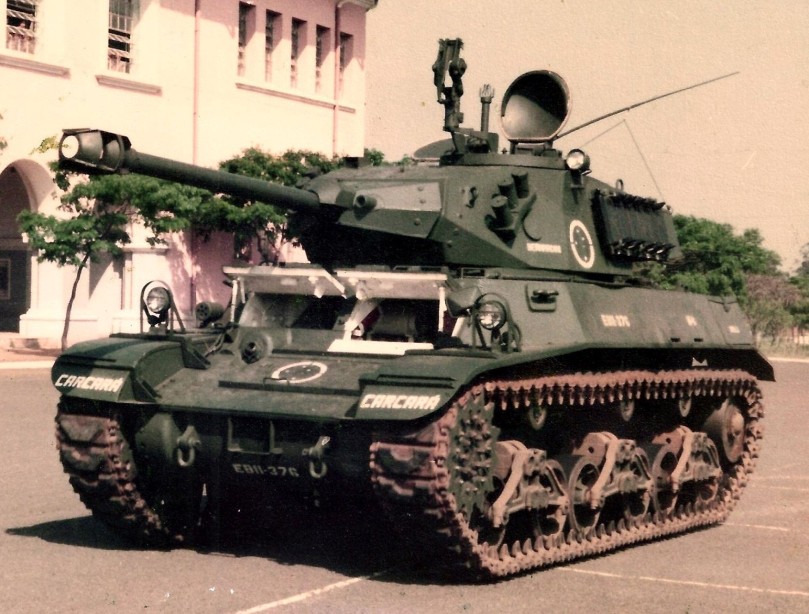
(The lone X1A1 in 1976. A carcara is a small falcon-like bird.) (photo by Miguel Q. Filho)
The X1A1’s track tensioning idlers were taken off the M4 Sherman, as it had been discovered that in real-world service, the increased power of the X1A basically put the strain of a bigger tank onto the little Stuart’s tracks.
Overall, the X1A1 was said to be of 60% new content. The X1A1 Carcara was favored above the X1A inside Bernardini as the company felt it had greater chances of generating foreign currency through export sales; either by selling straight out of Brazil’s inventory, or, by converting Stuarts of foreign armies.
It was planned to finish the remainder of the original early-1970s X1A order as X1A1s, possibly joined by another dozen or so additional Stuarts. However only one X1A1 Carcara was ever made. The modifications to existing M3 Stuart hulls were extensive enough that the money and man-hours required cut the tank in half, “un-do” the deleted WWII components before new gear was installed, and then complete an assembled vehicle onto the re-attached WWII lower hull; were approaching parity to just building the entire thing from scratch.
Which is exactly what was proposed next.
the X1A2 Carcara
Three and a half decades after it left American production during WWII, this was the final Stuart derivative, with development starting in 1979. However it did not utilize any existing WWII tanks but rather was new-built top to bottom.

The X1A2 used all experiences gathered from the X1A1 but was 8″ longer overall. Like the X1A1, it had three Novotraçao suspension bogies but also new Brazilian-made tracks which kept the ground pressure the same despite the added weight. An Allison CD-500 transmission was used.

(photo by Gino Marcomini)
The prototype X1A2 was fitted with the same 90mm DEFA gun used on the X1A and X1A1.

(The prototype X1A2 with the French 90mm main gun.)
However the rest received a Belgian-made Cockerill 90mm gun which was said to offer comparable performance to a 105mm weapon. This gun fired armor-piercing ammunition but was designed to exert minimal recoil on the host tank. The turret itself was a completely new design with a lower profile (it also allowed an extra 6 rounds to be carried), and the Cockerill gun was aided by a laser rangefinder. The commander’s cupola rotated.

(The ultimate turret and gun fit on a later X1A2.)
The X1A2’s weight was 21 tons. To compensate the Saab-Scania engine’s output was increased to 300hp. The X1A2 was 1mph slower on pavement than a WWII Stuart but much faster off-road on account of the new suspension and tracks. The fourth crewman position was eliminated along with the bow machine gun.

It might seem questionable to build from scratch a half-clone of an obsolete WWII tank, and maybe it was. For Brazil, the justification was that it sped the process up: knowledge gained from the X1A and X1A1 could be fully used, and simply copying the remainder of the WWII M3 Stuart was faster than designing a completely new lower portion.
After the lone prototype, a total of 29 X1A2 Carcaras were built in one 1979 – 1983 production run. Of the 29, only 24 were actually issued, all going to the Brazilian army’s 6th Armored Cavalry Regiment.
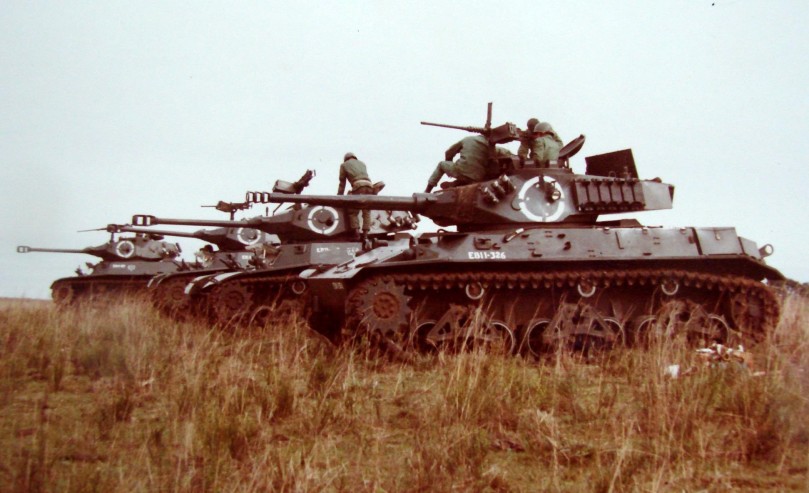
The X1A2 tanks were more successful in service than the X1As had been. They were well-liked vehicles by their crews. As one example, the control hand levers had a power “assist” that made driving the tank less exhausting to that crewman than the WWII original.
After the tanks were already entering service, questions were raised within the Brazilian army as to the new turret’s armor performance. Bernardini rated it to modern 20mm AP rounds and possibly some even larger (23mm) of older types or at longer ranges and/or steep impact angles. However an unsanctioned estimated felt that much of the turret could actually be defeated by 50BMG at 200yds and even by the M2 .30-06 AP cartridge of WWII at closer ranges.
The project also became mired down in Bernardini’s business woes which are described later.
As far as de jure tanks, this was the end of the line for the M3 Stuart. However during this whole 10-year period, which ran from the original WWII tank modernization concept in 1973 to the last brand-new X1A2 being delivered in 1983, a wide variety of Stuart offshoots were designed for other roles.
SPAAG variants
In military terms “SPAAG” is a Self-Propelled Anti-Aircraft Gun; a tank-like chassis mounting a low-altitude AA system.
The SPAAG derived from the above tank projects was designated VBC-AAe (anti-aircraft armored combat vehicle, in Portuguese) and later XM-3E1.

(Prototype XM-3E1 SPAAG.)
This was actually not the first project of this type. In 1969, one Brazilian M3 Stuart had its turret replaced by a M45 quadmount for the Browning M2 .50cal machine guns, each fed by a 200-round tombstone magazine. In all other respects it remained a WWII baseline Stuart. A marginal success, it was not followed up on.
The late 1970s XM-3E1 was to be a conversion of basic M3 Stuarts using the lower portion of the X1A tank conversion as its foundation. No turret was fitted but instead, a M45 quadmount was installed. The M45 was taken off M55 towed AA trailers which the Brazilian army had already purchased from the USA. In the AA role, the M45 had been quite successful during WWII and also during the Korean War; with some still in use during the Vietnam War. The four guns could be used as-is or “tuned in” by minute adjustments on the mounting so that their bullet streams converged at a preset point in the sky. All four guns could be fired at once, or the top/bottom pairs alternated so that the barrels took longer to overheat.
The M45 quadmount was also useful in the ground-to-ground role; all four .50cal guns firing delivered a total of 1,800rpm which was a lot of lead to send downrange.

On the XM-3E1, all lower portions were a X1A tank. The M45 quadmount rotated on a new electrically-operated ring.
The XM-3E1 was not approved for production. Militarily as a SPAAG, it lacked an onboard radar unlike then-current SPAAGs like the USSR’s ZSU-23-4 Shilka; meaning that it would be limited to daytime engagements below cloud level. The main factor however was economic: with the X1A’s production being curtailed, each XM-3E1 would be too expensive on their own.
There was another issue, in that Bernardini originally wanted the SPAAG variant to carry a remotely-operated twin Brazilian 20mm autocannon then under development. The M45 was only supposed to be an interim option to get orders going. That 20mm weapon was itself cancelled.
There was a completely separate, second SPAAG proposed that would have paired a X1A lower hull conversion with a naval Bofors L/60 40mm AA gun. It was cancelled while still on the drawing board.
bridgelayer
Originally designated VLB L-Pnt (special armored car, bridge-thrower in Portuguese) the XLP-10 was a bridgelaying variant.

(XLP-10 being tested in 1979.)
All propulsive portions, and most of the armored lower part, was simply a X1A tank conversion of the Stuart. A hydraulic stabilizer blade was fitted to the glacis. Instead of a turret a new metal superstructure was installed. It carried the heavy lifting pistons to lay a combination aluminum-steel bridge.
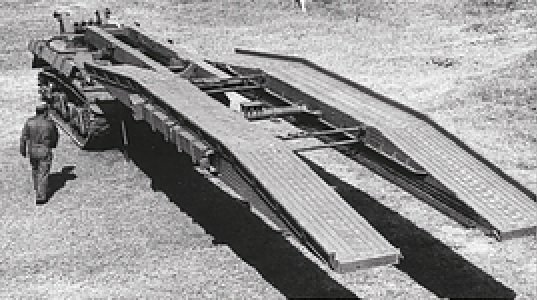
The bridge itself weighed 3 tons and could bear a 22 ton weight, spanning a maximum of 33′. To deploy it, the XLP-10 parked on the near side of the gap, lowered the blade, and swung forward the bridge until it rested on the ground. The cantilever arms then disengaged it, and the XLP-10 backed away. To retrieve the bridge, the process was done in reverse. The process took only three minutes.
The XLP-10 had a 2-man crew, the driver and a bridge engineer. The vehicle itself with the bridge stowed could ford water 3’3″ deep. It had the same cross-country mobility as the X1A tank conversion, and was envisioned to operate alongside it.
Of all of Brazil’s post-WWII M3 Stuart projects, this was the most successful. It was originally planned to follow the prototype with 10 conversions. However the XLP-10 was halted after the fourth production conversion.
With many of the Stuart projects, Brazil was sort of “competing against itself” in that multiple manufacturers were designing vehicles that filled one of the niches envisioned for the converted WWII tanks. In the case of the bridgelayer, not only was Brazil as a whole doing this but Bernardini as a company was “competing against itself” in that it simultaneously was marketing its XLP-20 bridgelayer conversion of WWII M4 Sherman tanks. It didn’t help that the bridge on the converted Sherman had a higher advertised payload than the XLP-10’s.

The four completed XLP-10s were issued in pairs to frontline Brazilian army units while the prototype was retained for training.
ballistic missile launcher
Brazil became interested in military rocketry during WWII.

(F114 rockets and launcher during 1966.)
Five years after WWII ended, Brazil developed an unguided surface-to-surface rocket designated F114. It was fired from a towed 5-round launcher converted from a British WWII towed AA gun’s carriage. This crude weapon had a range of 13½ miles, a puny warhead, and very poor accuracy.
In the late 1960s, a solid-fueled unguided bombardment rocket was developed and paired with a converted WWII vehicle as its launcher.

This system used two 8-round packs of unguided rockets set onto a turret designed by Arsenal da Urca, mounted on a WWII M8 Greyhound armored car.
By the 1970s, what the Brazilian army really wanted was something bigger. In South America during this time, large rockets and small ballistic missiles were viewed both as a legitimate wartime asset and as a national prestige item. Brazil and Argentina both had active ballistic missile programs while Peru and Chile were also exploring the technology.
Between 1972 – 1975, Avibras in Brazil developed the X-40. Blurring the lines between a large battlefield rocket and a small ballistic missile, the X-40 was powered by a single-stage, solid-fueled rocket. The X-40 was roughly 11¾” in diameter, weighing ¾ of a ton with a 324 lbs HE warhead. It had a maximum range of 42 miles.

Bernardini proposed a variant of the modernized WWII M3 Stuart as its launcher. This vehicle, the XLF-40, used the X1A tank conversion’s lower portion as its base. The vehicle itself weighed 17 tons. It had a 4-man crew, the driver, commander, and two missile technicians.

(XLF-40 with X-40s in 1979.)
Modifications were elimination of the turret and guns, a stabilizing spade on the glacis and two stabilizing legs on the rear, and the three-rail missile launcher. With three missiles onboard, the XLF-40 could travel 34mph on level, paved roads.
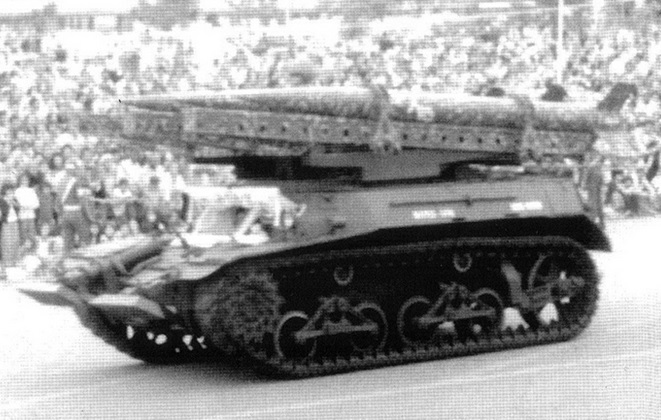
(photo via lexicarbrasil website)
Both the XLF-40 and the X-40 itself had problems, both in substance and style. As a weapon, the X-40 was a ballistic missile only in the loosest use of the term. Its guidance kept it pointed down the direction it was launched at but was incapable of correcting for crosswinds or differing air densities at higher altitudes.
A comparable Soviet weapon of the era, the 9K52 FROG-7, had similar range but carried a ½ ton warhead compared to the X-40’s 324 lbs model. Given the low accuracy and small warhead size, all three missiles aboard a XLF-40 would probably need to be fired against a target such as an enemy fuel depot to inflict any sort of appreciable damage, and probably more than one launcher would be required. Against an “area target” like an enemy artillery spread, an entire multi-vehicle firing battery would almost certainly be required.

(XLF-40 test-firing a X-40 during the 1970s. The lineage to the WWII M3 Stuart is apparent from this angle.)
Bernardini marketed the X1A Stuart tank conversion’s lower half as a way to give the X-40 cross-country mobility. However, assuming for example a theoretical six-vehicle firing platoon, it would need a dozen or more wheeled trucks and support vehicles to keep it reloaded and operational anyways. For maximum benefit some sort of third-party targeting via radio would be needed; and presumably a wheeled communications vehicle would be required as well.
No help was given by the fact that Bernardini was simultaneously offering a dirt-cheap, single-rail launch trailer for the X-40 that could be towed by its BT50 Bandeirante 4×4 truck.

Within the Brazilian army, this naturally led to the question: if the tracked launcher would require wheeled support vehicles anyways, and with the towed launcher being infinitely less expensive, did it even make sense in the end to even have the XLF-40?

In the end it was moot because without co-production of the tank, bridgelayer, and support versions of the project; the missile launcher variant would be too expensive on its own anyways. By the early 1980s Brazil’s concepts had diverged into two paths, the very successful Astros-II MLRS which fires large numbers of rockets to about 20 miles, and true theatre ballistic missile programs which were all later abandoned. Only one XLF-40 was completed. It continued in use with the X-40s, which although abandoned as a battlefield weapon were used for research through the 1980s.
support versions
Never entering series production, these variants stretched what can even be considered as a descendant of the WWII Stuart tank.
All these versions shared a common Bernardini “chassis box” that weighed about 5 tons.

(photo via O Stuart No Brasil book)
Depending on the version, they were (loosely) based on the X1A1 or X1A2 tanks (the latter resulting in a longer chassis box) but with major changes. The engine was a 180hp Mercedes-Benz diesel, mounted in the vehicle’s front. The height and length of the vehicle was obviously different than any of the tank, bridgelayer, or missile versions. The crew positions were entirely changed around.
Really the only thing still linking these vehicles to the WWII tank was the Novotraçao suspension layout.
Early on it was decided that the chassis box would be a failure as an armored personnel carrier, as the Stuart was simply too skinny to house an infantry squad carrying rifles. Instead a number of niche-role vehicles were proposed.

The XM3B1 was a mortar carrier. The rear compartment, which was covered by a fold-out roof, housed a Raiado 120mm mortar with a range of about 4 miles. Atop the vehicle was an open M2HB Browning .50cal machine gun.
The XM3B1 was not a success. During tests of the lone prototype, the mortar’s recoil was shown to have been underestimated and dished the vehicle’s underside down to the point it became unserviceable. To rectify this, a unique angled mounting was made on the glacis whereby the vehicle’s whole weight would act against the mortar’s recoil. To use it, the mortar crew had to hand-carry the mortar out of the rear ramp, and bolt it into the front of the XM3B1, and then remain exposed to fire and reload it. To the Brazilian army, this was no benefit compared to the normal way of deploying the Raiado (towing it behind a jeep).
The other vehicle on the “chassis box” concept was an armored repair vehicle.

This vehicle was developed jointly by Bernardini and CTEx (the Brazilian army’s technology center). It was to be entirely new-built using no actual WWII parts, but none the less still based on the X1A2 offshoot of the M3 Stuart. It was 17’2″ long and had a top speed of 30mph.
This vehicle had two cable winches, one external in the front and one inside the rear compartment. These could be use to free stuck vehicles, either wheeled or tracked. On the vehicle’s rear were two hydraulically-lowered stabilization legs. A remote-control hydraulic arm crane laid flat atop the vehicle for transit. In the rear compartment were various repair tools. This vehicle had two fire extinguishers, one inside the rear compartment and the other carrier externally on the glacis armor. It was armed with a M2HB Browning .50cal machine gun.
This vehicle, while potentially a good design, was competing against a repair version of the 6×6 EE-11 Urutu armored car, manufactured by Bernardini’s competitor Engesa. While the Stuart-derivative design had slightly better mobility due to being tracked, the Urutu offshoot was better in most every other way and was also at the start of its development curve, as opposed to being the last gasp of WWII technology.
There were several other versions of the chassis box proposed, including an armored ambulance and a mine clearer; none of these ever advanced far. The repair vehicle version was considered to have the best odds of success and was still being marketed as late as 1989.
All these fell victim to a “chicken & the egg”-type scenario: while they may have been good, none of these variants could be built profitably alone, but Brazil was hesitant to order any, hence the dilemma continued.
end of the road

(The lone X1A1 M3 Stuart conversion.)
None of the support versions, the missile launcher version, or the X1A1 were ever selected for operational use. Only 4 XLP-10 bridgelayers were made, along with the 53 X1A converted M3 Stuart tanks and the 29 new-built X1A2 tanks.
Inside Brazil there was something of a stigma to the project, as although the M3 Stuart had a great Brazilian career during WWII and long after; it was thought of as yesterday’s weapon by the end of the 1970s. Bernardini hoped to generate the same interest that the Israelis had captured with their upgrades of WWII M4 Shermans and M3 half-tracks. But it was not to be, especially as the project’s timeline extended into the completely new-construction X1A2. In particular the derivatives like the repair vehicle, were negatively commented on in that while they had good features, it seemed that traits of the Stuart were being artificially “shoehorned in” to an essentially new thing, for no apparent reason or benefit.
Outside of the country, Brazil, and / or Bernardini depending on how one chooses to look at it, greatly overestimated the zeal with which the M3/M5 Stuart was viewed with by the few countries still operating the WWII tank in the 1970s. These countries; like Nicaragua, Paraguay, and Haiti; were not particularly in love with the WWII tank anymore but simply could not afford anything to replace them, and thus made a dim market prospect for upgrades.
One of the problems with this whole concept was that often, Brazil was “competing with itself”. For example the niche the X1A1 / X1A2 projects were supposed to occupy was also being competed against by the EE-17 Sucuri project. In some cases Bernardini was also itself “competing against itself” as a company; for example while the M3 Stuart-derived bridgelayer was being offered, the company was simultaneously offering a M4 Sherman-derived model.

A lot of the regional militaries who opted to upgrade WWII-era American armor, simply found cheaper and simpler options.

(A Colombian army WWII M8 Greyhound upgraded with new autocannon and launcher for BGM-71 TOW wire-guided missiles.)
Brazil pulled the X1A2s from service in the late 1990s, hoping to sell them as a lot to a foreign user. However none was forthcoming. Paraguay was the last operator of the baseline M3/M5 Stuart worldwide, retiring the last examples in 2018.
Bernardini was sent into an inescapable financial spiral by the Stuart upgrades, along with other issues. While the Brazilian government was subsidizing the efforts, even in a best-case scenario (a clean financial wash) the company was not making much money on them and in the cases of the failed versions, nothing at all. Bernardini had several unrelated “dream big” new tank designs, such as the MB-3 Tamoyo of 1983 and Tamoyo III of 1987, which were also failures.
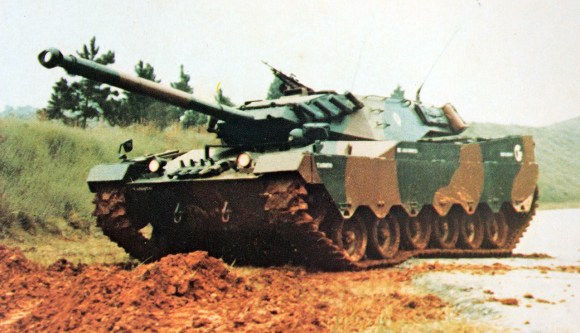
(MB-3 Tamoyo prototype being tested in the 1980s)
The company went bankrupt in 1992, nineteen years after the initial forays into the tank upgrade market.

(Stored Brazilian M3A1 Stuarts in 2008.)
One silver lining to this story is that Brazil preserved a large number of Stuarts in the 1980s awaiting conversions that never came. This was at the same time when WWII tanks worldwide were still being widely scrapped. Today a significant number of Stuarts in museums are ex-Brazilian.
In any case, the Stuart is remembered as a quality tank of WWII and the Brazilian offshoots are an interesting footnote to the tank’s history.


Fascinating. It’s interesting to compare with Germany’s numerous innovations in WW2 of putting bigger guns onto obsolete light tanks. With the Pz. II, they could only manage the 75mm in a fairly vulnerable open top (turret-less) tank destroyer role. The “Hetzer” was a bit more successful, getting the 75mm into a closed top chassis of the Czech 38t. It had fairly good armor, but still had limited traverse, lacking a turret. Admittedly Brazil’s installation of a 90mm gun into a turret on a Stuart is even more impressive! (Side note: I realize your time/space is limited, but would have liked to have learned a bit more about Brazil’s deployment and use of M3s in WW2.)
LikeLiked by 1 person
The BEF (Brazilian Expeditionary Force) was about the size of an overstrength US Army division and included the country’s only alpine warfare unit. It had, besides the Stuarts, M3 half-tracks. I dont believe the Brazilian Stuarts were involved in any fixed-pitch tank battles but I may be wrong. Brazil also operated the FT-17, an old French tank design, during WWII but none were shipped to Italy.
LikeLiked by 1 person
The Brazilian Expeditionary Force (Força Expedicionária Brasileira, FEB) did not use Stuart tanks. The only armour they had was the M8 Greyhound scout vehicle.
The first photograph shows 5 of the 10 M3 Type 2 Mk.I Stuart tanks of the Moto-Mechanization School (Escola de Moto-Mecanização, EsMM). They were numbered 1-10 and received painting on the 4 sides of the turret with the archaic Army symbol (according to the 16456-A Decree of August 2020). This famous photograph was published in the Brazilian magazine “Em Guarda”, an official publication from 1941-46 intended to foster Pan-Americanism.
The photograph with the following caption has the date wrong: “(Stuarts on parade in Sao Paulo in the mid-1950s. After WWII, the Brazilian army tried to organize these tanks into platoons by engine type – this being an all-Guiberson unit.)”
It is, in fact, the Brazilian Independence Day with the traditional military parade in September 7, 1945. Those diesel-engine M3 tanks are a platoon of the 1º BCCL (1º Batalhão de Carros de Combate Leves/ 1st Light Tank Battalion) ready for the parade at the Anhangabaú Valley, in the city of São Paulo.
One curiosity, one of the Brazilian Stuart tanks was gifted to the British Tank Museum, in Bovington:
LikeLike
Hello, I was wondering what your source was on the Armor plate performance of the X1 (so the ability to block 20mm rounds). Thank you very much,
Darren
LikeLike
It is an old Jane’s Land Systems from the 1980s
LikeLike